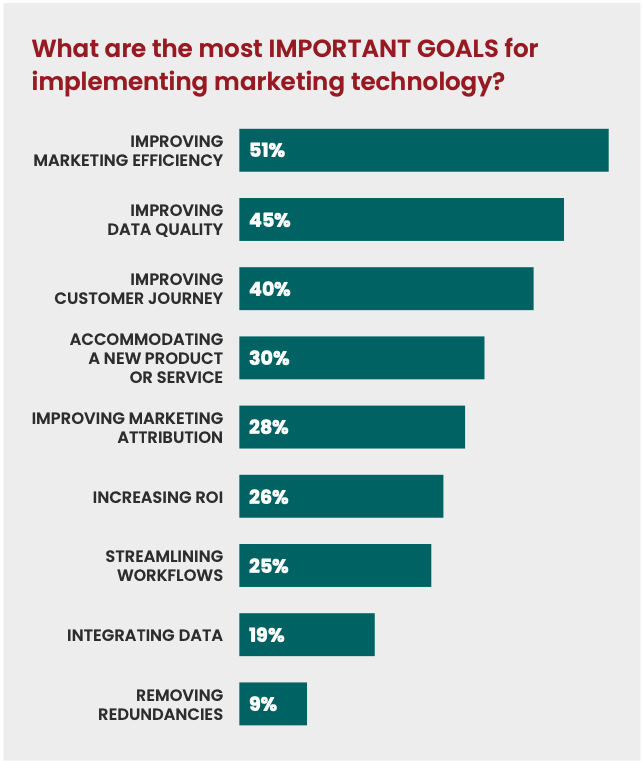Email Marketing
Marketing Technology – How to Compare and Evaluate Your Options

Email Marketing

In marketing circles, we never tire of the phrase, “work smarter, not harder.” There’s been an explosion of tech solutions designed to make our lives and jobs easier while helping us work more efficiently as a team. There are so many options out there, but it’s easy to get overwhelmed when it’s time to evaluate and compare marketing technology.
For instance, think about the myriad possibilities you have to wade through when looking for an email service provider (ESP). There are literally hundreds of vendors out there, each vying for your attention with different price points, functionalities, service levels, contract terms, and integrations.
From sales demos and internal meetings to budgets and security concerns, it takes time to evaluate and compare marketing technology. In this article, we’ll go over what marketing technology is, the best tech solutions for digital marketing, and some questions you’ll need to answer before designing your own marketing tech stack from scratch.
Finally, we’ll leave you with our report, Getting the Most from Marketing Technology, which surveyed best-in-class marketers about how they identify, compare, and implement tech tools for their teams.
Alright, let’s dive into all that lingo. For this article, there’s only one you truly need to get to know: MarTech.
Marketing technology, also known as MarTech, is a range of software and tech tools that help marketers achieve their goals or objectives. MarTech can be anything from email automation to optimizing SEO to managing large datasets used in email marketing.
As you can imagine, each of these is crucial to the modern marketing experience. In fact, building your own MarTech stack is essential to improving your email marketing campaigns. Use MarTech to design an email marketing workflow that works well for your team and suits your business needs.
Cold emailing just doesn’t cut it anymore. In the modern world of digital marketing, you need to consider so much more, including crafting customer experience and designing top-notch marketing strategies.
Here are the best marketing technologies we think are crucial to the success of any email campaign:
But when marketers rely on models to determine their own marketing attribution, they run into problems like correlation-based bias, missed message signals, and in-market bias. Instead of relying on outdated models, marketing attribution software helps you identify key opportunities so you can develop the optimal email marketing tactic.
In our report, Getting the Most from Marketing Technology, we surveyed best-in-class marketers about how they identify, compare, and implement tech tools for their teams. Here are some key questions these marketing leaders ask as they make purchase decisions and evaluate existing solutions to build a MarTech stack that fits their brand’s needs:
Let’s unpack each of these questions below.
A good MarTech stack (the collection of software employed by marketing departments) helps you drive productiveness and ultimately do more with fewer resources (people, time, and money). Tech platforms should enable email marketing teams to stay lean and focused while also allowing them to significantly scale their efforts.
Our survey with Ascend2 found marketing leaders most often cited these goals as the top three reasons for implementing a new tech tool:

Innovation can sometimes be a distraction. Before you chase the latest and greatest marketing automation tools, make sure you know what problems you aim to solve with them and what you expect to get from implementation.
Takeaway: The procurement process of any new platform should always start with a clear view of your objectives and the roadblocks that prevent you from reaching your goals. Do you need to drive more leads, optimize your conversion rates, or increase your customer lifetime value?
Throughout our report, marketing leaders cited ease of use as a crucial factor when they compare marketing technology.
Software is very much like a gym membership. You’ll only see improvements if you use it regularly. So your colleagues must understand the benefits of adding to your MarTech stack and commit to its adoption.
Any new software will require a degree of investment in training and calibration to become a useful resource in your organization. Don’t expect to share a username and password and have your already busy team pick it up and run with it. That’ll never happen.
It’s always a good idea to have more than one team member involved in implementing a new product. This approach will not only ensure you have a more accessible level of expertise in the product, but it will also guarantee that the knowledge is maintained should you lose a member of your team.
There will always be a degree of disruption when implementing a new piece of technology. Sharing the knowledge across your team will ensure that process doesn’t have to start from scratch in the event of that knowledge leaving your organization.
Takeaway: Succession planning is essential here. Ensuring you have more than one person trained on the solution or tool guarantees you won’t miss a beat should a teammate decide to leave or if they win the lottery.
Compatibility across your existing systems is a priority. If a new piece of technology doesn’t integrate with your wider stack, you’ll probably create more work for your team as they manually transfer data between systems. This not only means your team becomes less efficient, but it also creates opportunities for mistakes to be made and reduces the reliability of the data.
When speaking to tech vendors, it’s essential to highlight the need for compatibility with your legacy MarTech stack. In the ideal world, there will be a direct integration via a readily available application.
Many software platforms, like Saleforce.com’s CRM system or Shopify’s ecommerce platform, have “app stores” offering approved “native” integrations. Then there are third-party tools like Zapier, which provide integrations between thousands of systems. This is a great approach if, for example, you are looking to share email data between a payment gateway like PayPal or Stripe and your ESP.
Many other technology platforms offer more complex API integrations, although they will incur a significant investment in technical support and require a more extended implementation period.
Takeaway: Do the research ahead of time to find out if it will integrate with your existing tools. Don’t rely on a salesperson to have that knowledge.
Data makes the world go round. It not only helps the marketing team make solid decisions based on how customers and prospects engage with campaigns, but it also proves to the wider organization the value of your activities. The more accurate and accessible your data, the greater your opportunity to influence senior leadership teams about future content marketing investments.
Integrations with the software used across your organization (such as your CRM system) will ensure the marketing team is able to bridge departmental communication gaps. This approach is advantageous when improving lines of communication between marketing, sales, and customer service departments.
However, it’s also important not to get lost in customer data for the sake of it. Data visualization works best when it is relevant to those viewing it – so it’s important the right data is shared with the right audience.
Takeaway: Knowing your audience and what they would like to learn from the data is the first step in ensuring you can tell the story to all stakeholders.
In our report, the ability to customize a marketing platform followed only ease of use as the top consideration for evaluating new solutions.
While there will be an element of customization available in many software-as-a-service (SaaS) products, some organizations demand higher-level customization. This need will typically be because they are running bespoke legacy systems that don’t provide “plug-and-play” integrations or their processes are too niche for “off-the-shelf” software.
Some software companies provide highly customized products – but these will significantly add to the costs of integration and may lead to problems in the future if that software is no longer supported.
Takeaway: When considering if software needs to be customized, you should always ask yourself if it may be easier to adapt your processes. And remember, one of the most dangerous things you can say in business is, “We’ve always done it this way.”
As your company grows, the last thing you want to do is completely rebuild your marketing stack. So, any software acquisition must not only be capable of managing your day-to-day needs today but also scale with your plans for the future. Consider the amount of data the software can handle, the number of users who can access the system, and the level of sophistication available to companies with ever more complex and ambitious needs.
It’s good advice to plan for the mid-term future and be two or three steps ahead of your organization’s current needs (again, based on your organization’s objectives). You probably don’t need to jump into the deep end with the most sophisticated services until you need them. It’s not unusual for some marketing organizations to utilize only 20% of their available technology. This underuse of resources does not represent good value for money, will significantly add to your costs, and drive down levels of efficiency.
Takeaway: Knowing where the company is headed and how much growth you can expect in the next 1-3 years will help when evaluating a new marketing technology.
Salespeople have a habit of telling you what you want to hear. Thankfully, there are many opportunities to confirm whether what they’re saying is legitimate and honest.
Turn to your professional network and social media to get some unfiltered opinions. A quick search on Twitter will give you a good idea of other users’ sentiments toward a particular product. A question posted on LinkedIn may reveal a slightly deeper insight as well as provide alternative recommendations.
There are many different comparison sites and buyers’ guides out there. Some of these will be advertising-led. So it will also be best to compare marketing technology based on several different sources.
However, the best recommendation will always come from other marketers. Case studies are helpful but will never mention any pitfalls.
Takeaway: Ask potential vendors for trade references who you can speak with directly when evaluating a new service.
As you get closer to making a decision on new marketing technology, price becomes an increasingly important factor.
Costs should always be balanced against benefits. This all comes down to knowing your objectives and understanding your numbers. If you are currently doing X with Y resources, how much more could you do with Z?
The research you do before pitching a new MarTech product to key stakeholders will be invaluable. They will want to see evidence of growth potential and efficiencies afforded by their investment. Get extra advice on asking decision-makers for more budget.
You’ll also need to get buy-in from the people who’ll use this technology on a daily basis. They may be concerned that their jobs will be less viable if technology helps pick up the slack. Reassure them that any investment in technology is an investment in their future careers and helps them do more in the long term. Remember, without their buy-in, it’ll be difficult to guarantee the new software is used to the best of its capabilities, and this may potentially result in poor outcomes.
Takeaway: Involving key stakeholders early in the process will help ensure a smooth decision-making process.
While some software will work intuitively out of the box, more complex solutions will require significant hand-holding and ongoing support.
You must understand the availability, costs, and timescales of onboarding and support packages. Any delays relating to onboarding or support could significantly impact the delivery of time-sensitive campaigns.
If the rollout of a new piece of marketing technology has the potential to impact negatively on a peak marketing period (like the holiday season), you should consider delaying any implementation until it can be successfully managed.
Takeaway: Coordinate your efforts across the organization. You don’t want to implement a new software when key people in other departments are out or when another team is in the middle of its own tech project.
When you compare marketing technology, you’re also evaluating potential business partners. Signing a contract or picking an annual plan means you’re entering into a relationship with a company. You’ll depend on that company to support your team and help you achieve specific goals.
At Email on Acid, we know a lot about what drives efficiency on an email marketing team. We’re proud to offer an email marketing solution you can trust. Our clients tell us that our email readiness platform saves them upwards of 2 hours of work per email send. With multiple campaigns going out each week, what could your team do with all this extra time?
This article was updated on October 19, 2022. It first published in March of 2021.
